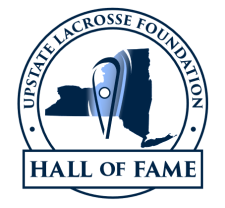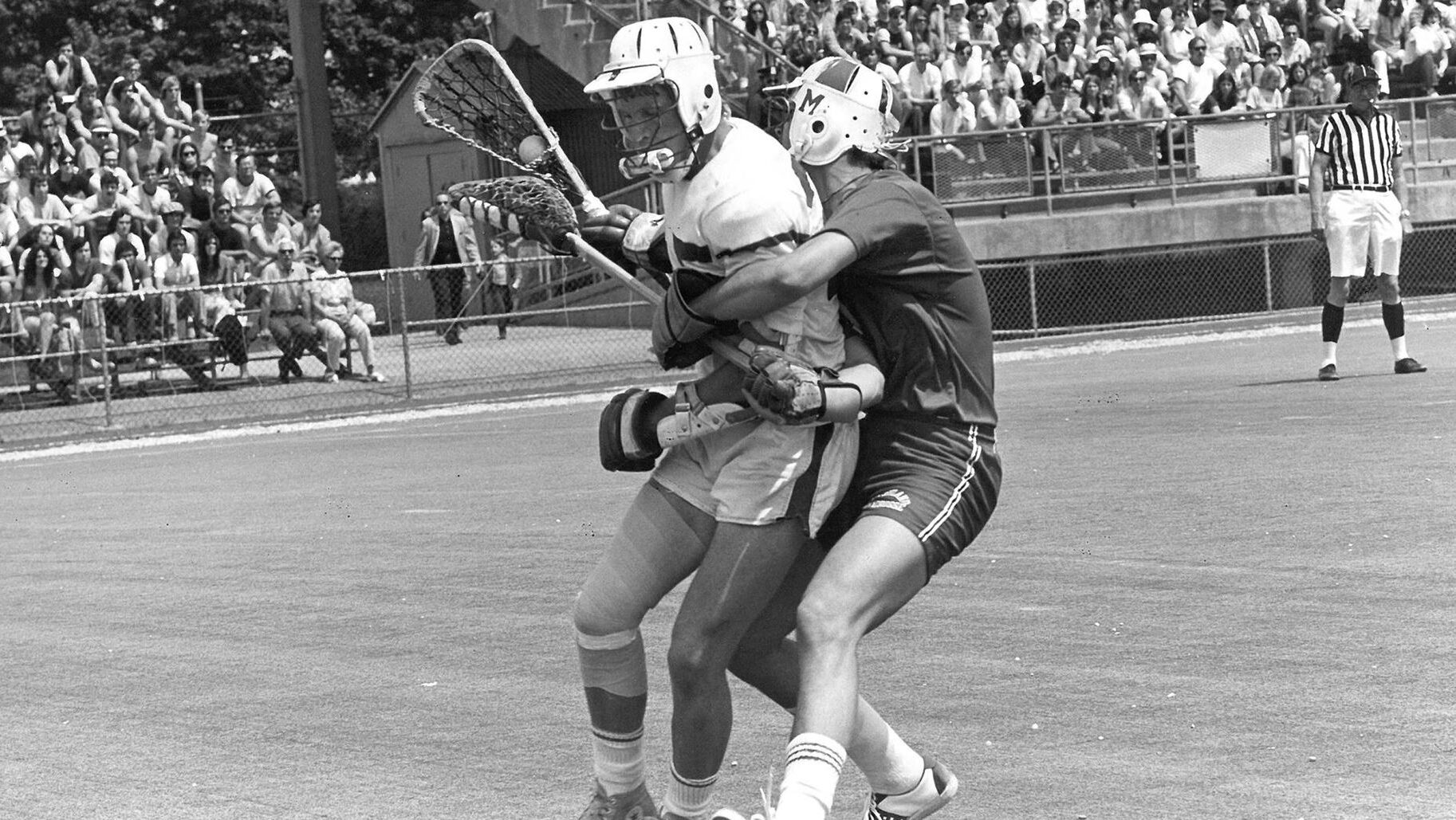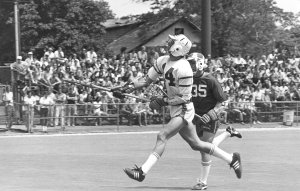1971 Cornell Men’s Team

1971 Cornell Men’s Team
By Christian Swezey
On the morning of June 5, 1971, the bus carrying the Cornell men’s lacrosse coaches and players pulled out of the Holiday Inn in Plainview, New York, a two-story, L-shaped building located between the Northern State Parkway and Long Island Expressway, and began driving southwest. After 20 minutes, the bus reached its destination, Hofstra Stadium in Hempstead. The Big Red had arrived for the first NCAA lacrosse tournament championship game, at the neutral site predetermined by the governing body for college athletics.
Maryland, Cornell’s opponent, was a member of the sport’s Baltimore establishment, the “Big Five” that dominated college lacrosse’s highest honors as voted by the U.S. Intercollegiate Lacrosse Association. Cornell had not won a national title since 1916, despite finishing undefeated in 1966, 1968, and 1970. (The USILA deemed the Big Red’s schedule not demanding enough to warrant even a share of the title.) The Terrapins entered Hofstra Stadium having won nine USILA national championships.
The Terrapins held the advantage in pedigree. Cornell had an advantage of its own in Coach Richie Moran. A Long Island native, Moran knew the artificial turf of Hofstra Stadium from his days as coach of the post-collegiate Long Island Athletic Club, which played home games there. In March 1971, with an eye on the inaugural title game, Moran scheduled a scrimmage for Cornell against LIAC at Hofstra. Maryland, like most mid-Atlantic teams, used a natural grass surface and had not played a game on artificial turf in years.
Moran’s local knowledge further came in handy after the NCAA announced the title game would be played on June 5. The same day, roughly eight miles from Hofstra, Elmont Park hosted the Belmont Stakes, the third leg of horse racing’s triple crown. In 1971, a record crowd of more than 81,000 people assembled to see if Venezuelan-born Canonero II, winner of the Kentucky Derby and Preakness Stakes, could complete the rare triple crown. Moran, not wanting any distractions, sequestered his team in quiet Plainview, far from the race crowds. Maryland stayed at the tony Island Inn in Westbury, much closer to Hofstra but also filled with boisterous people traveling to the Belmont the following day.

Gameday arrived warm and bright, with temperatures in the mid-80s. Cornell senior Bob Rule, just days from being named a first-team all-American goalkeeper, took the field for warmups in his customary white jersey, red sweatpants, white helmet, and heavy wooden stick. There was no chance Rule would play; he had suffered a knee injury in the final game of the regular season, a 21-6 victory over Princeton, and re-injured it in opening minutes of the NCAA first-round win over Brown. (Rule’s red sweatpants concealed a huge knee brace.) In his place bounded senior Bob Buhmann, also hiding, at least from most fans, an ailment of his own. As a student at MacArthur High School in Seaford, New York, Buhmann received a diagnosis of epilepsy. Colleges learned of the diagnosis and showed little interest in recruiting him. Buhmann enrolled at Nassau Community College. There, he led the Lions to 32 victories in 34 games. Once again, college coaches did not show interest. Moran’s Long Island connections persuaded him to give Buhmann a shot, and the goalie arrived in Ithaca in the fall of 1969 classified, as friends later said, as a student with a disability.
Buhmann was not the only outlier in Cornell’s starting lineup for the first title game. Senior Al Rimmer, the leading scorer in the Ivy League, was the only native of Canada to play in the inaugural NCAA tournament. The night before the title game, someone stole Rimmer’s turf shoes, and he took the field wearing Chuck Taylor canvas high-top sneakers that belonged to a team manager. Also in the starting lineup were two football players, defensemen John Burnap and Bill Ellis, and one basketball player, attackman Glen Mueller. Junior Frank Davis, the third starting attackman, took the field using a wooden stick he had made himself. Davis had learned how to create and, crucially, how to fix, the heavy wooden lacrosse sticks as a child on the Tuscarora Native American Reservation in Sanborn, New York, near Buffalo.
On the other sideline were the Maryland players, almost all of whom hailed from the sport’s established proving grounds of Baltimore and Long Island.
A crowd of around 5,700 people settled into their seats at Hofstra Stadium, having spent either $3 for a reserved seat or $2 for general admission. In Ithaca, fans could tune their radios to WHCU-AM and FM for a pregame show at 1:50 p.m., followed by play-by-play coverage from Jay Levine, with color commentary provided by former varsity lacrosse coach Bob Cullen. In Baltimore, the game was available on WBAL-TV, which dispatched its color TV cameras and two announcers to Hofstra. The city’s NBC affiliate showed the lacrosse game rather than the offering from the network, the Major League Baseball Game of the Week.
At 2 p.m., the lacrosse game began. Less than one minute into the contest Rimmer scored. Maryland answered. The teams traded goals again before Rimmer scored three consecutive goals, the last of which gave Cornell a 5-2 lead. The Big Red extended the lead to 8-3 at halftime, then 10-4 at the end of the third quarter. Maryland threatened briefly in the final quarter, closing to 10-6 before Cornell scored twice more to seal the 12-6 victory. It was a day for underdogs; at Elmont Park, 8-1 longshot Pass Catcher defeated a 13-horse field to win the Belmont Stakes. Canonero II finished fourth.
At Hofstra, Rimmer finished with six goals, nearly outscoring Maryland by himself. Buhmann added 22 saves, at least six of which came on shots from five yards, where the offensive player has a significant advantage. One reporter in the press box, following another acrobatic save by Buhmann, noted the goalie’s backup status for much of the year. “Rule,” he said, “must be incredible.”
After the game, Moran stopped for an interview with the WBAL commentators. His voice was an unusual mixture of elation and irritation.
Do you think we showed Baltimore something? Do you think they’ll rank us as high as third?
Richie Moran
Cornell sports information director Ben Mintz, Cornell Class of 1943, was the first person to take the mahogany-and-gold rectangle of an NCAA lacrosse trophy and present it to Moran. The celebrations were about to begin.
In spring 2022, Christian Swezey, whose work has appeared in the Washington Post and Inside Lacrosse, will publish his history of Cornell men’s lacrosse in the 1970s. We Showed Baltimore: The Lacrosse Revolution of the 1970s and Richie Moran’s Big Red chronicles the rise of the Cornell program from Ivy League dominance in the 1960s under Coach Ned Harkness to the heights of the national game with NCAA championships in 1971, 1976, and 1977. Swezey’s piece above, commemorating the 50th anniversary of the Big Red’s 1971 victory over the Terrapins of the University of Maryland in the inaugural NCAA championship game, is adapted from the forthcoming book which will be published by Three Hills, an imprint of Cornell University Press.

Hall of Fame Class of
2021
Hall of Fame Category
Team/Group
College Team
Cornell University
Pro Team(s)